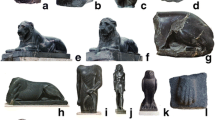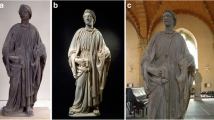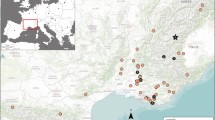Abstract
With occasion of the “Murillo’s year” (fourth centenary of his birth), the Andalusian Institute for Cultural Heritage (Instituto Andaluz de Patrimonio Histórico) received the request from a private collector for the restoration and authentication of a bozzetto of the Murillo´s painting entitled Moses and the water from the rock of Horeb. During the intervention, several studies on the materials employed were carried out—on the bozzetto and on the final large dimension painting, to characterize the different components of the paintings (ground layer, pigments and binders), as well as to confirm/reject the authenticity of the bozzetto. After a detailed general inspection using multispectral techniques (visible, UV, IRR) some pentimenti were discovered. In addition, Macro X-ray fluorescence (MA-XRF) scanning technique was performed, complemented by point XRF and stratigraphic analyses. The results show that the ground layers were prepared in the usual fashion of the artist, using earths, calcium carbonate, iron oxide pigments and white lead. MA-XRF mapping allowed determining the spatial distribution and the combination of these pigments along the surface of both paintings. Results show that canvas, priming, binders, pigments and painting techniques of the bozzetto are compatible with those of the original painting, so we can conclude that most likely this is the original Murillo’s bozzetto.












Similar content being viewed by others
References
Aldrovandi A, Picollo M (2003) Metodi di documentazione e indagini non invasive sui dipinti. Il Prato, Padua
Angulo Íñiguez D (1981) Murillo Su arte, su vida, su obra (Part I). Espasa Calpe, Madrid
Artioli G (2010) Scientific methods and Cultural Heritage: an introduction to the application of materials science to archaeometry and conservation science. Oxford University Press, Oxford
Asperen Van, de Boer JRJ (1968) Infrared reflectography: a method for the examination of paintings. Appl Opt 7(9):1711–1714
Bray X (2013) Murillo at Dulwich picture gallery. Dulwich picture gallery. Philip Wilson Publishers, London
Bruquetas Galán R (2002) Técnicas y materiales de la Pintura Española en los Siglos de Oro. Fundación de apoyo a la Historia del Arte Hispánico, Madrid
Casini A, Lotti F, Picollo M, Stefani L, Buzzegoli E (1999) Image spectroscopy mapping technique for noninvasive analysis of paintings. Stud Conserv 44(1):39–48
Cosentino A (2015) Practical notes on ultraviolet technical photography for art examination. Conservar Patrimonio 21:53–62
Deming Glinsman L (2005) The practical application of air-path X-ray fluorescence spectrometry in the analysis of museum objects. Stud Conserv 50:3–17
Durán A, Siguenza MB, Franquelo ML, Jde Haro MCJ, Justo A, Perez-Rodriguez JL (2010) Murillo’s paintings revealed by spectroscopic techniques and dedicated laboratory-made micro X-ray diffraction. Anal Chim Acta 671:1–8
Kriznar A, Ager FJ, Caliri C, Romano FP, Respaldiza MA, Gómez-Morón MA, Nuñez L, Magdaleno R (2019) Study of two large-dimension Murillo’s paintings by means of macro X-ray fluorescence imaging, point X-ray fluorescence analysis, and stratigraphic studies. X-Ray Spectrom 48:482–489
Kühn H, Roosen-Runge H, Straub RE, Koller M (eds) (1997) Farbmittel, Buchmalerei, Tafel- und Leinwandmalerei. Reclams Handbuch der künstlerichen Techniken, Bd. 1, Philipp Reclam jun., Stuttgart
Matteini M, Moles A (1994) Scienza e restauro Metodi d´indagine. Nardini, Firenze
Miller JL (1994) Principles of infrared technology: a practical guide to the state of the art. Springer, New York
Navarrete Prieto B (2017) Murillo y las metáforas de la. Ed. Cátedra, Madrid
Romano FP, Caliri C, Nicotra P, Di Martino S, Pappalardo L, Rizzo F, Santos HC (2017) Real-time elemental imaging of large dimension paintings with a novel mobile macro X-ray fluorescence (MA-XRF) scanning technique. J Anal Atom Spectrom 32:773–781
Santos HC, Caliri C, Pappalardo L, Catalano R, Orlando A, Rizzo F, Romano FP (2018) Real-time MA-XRF imaging spectroscopy of the Virgin with the Child painted bz Antonello de Saliba in 1497. Microchem J 140:96–104
Seccaroni C, Moioli P (2004) Fluorescenza X: Prontuario per l’analisi XRF portatile applicata a superfici policrome. Nardini editore, Firenze
Tomlinson H, Howard H, Peggie D, Ackroyd P, Carr D (2011) Murillo’s christ healing the paralytic at the pool of Bethesda: an introduction to the artist’s late painting technique. In: Conference: studying old master paintings: technology and practice, vol: the national gallery technical bulletin 30th anniversary conference postprints, pp 173–179
Volpin S and Appolonia L (2020) Le analisi di laboratorio applicate ai beni artistici policromi, Il Prato, Padova
West Fitzhugh E, Feller RL, Roy A, Berrie B (eds) (2012) Artists’ pigments: a Handbook of their history and characterisation. Archetype Publication, London
Acknowledgements
The authors very much appreciate the unique offer of Mr. Wüllner to study the bozzetto, as well as the collaboration of the IAPH professionals Lourdes Núñez Casares and Eugenio Fernández Ruíz. This research was possible thanks to the financial support by “Fundación La Caixa”, “Humilde y Real Hermandad de la Santa Caridad de Nuestro Señor Jesucristo” and “VI Plan Propio de Investigación de la Universidad de Sevilla”. The authors wish also to acknowledge the professional support of the Interdisciplinary Thematic Platform from CSIC Open Heritage: Research and Society (PTI-PAIS).
Author information
Authors and Affiliations
Corresponding author
Additional information
Publisher's Note
Springer Nature remains neutral with regard to jurisdictional claims in published maps and institutional affiliations.
Rights and permissions
About this article
Cite this article
Kriznar, A., Ager, F.J., Caliri, C. et al. Scientific study of the bozzetto of Murillo’s painting “Moses and the water from the rock of Horeb”. Rend. Fis. Acc. Lincei 31, 795–805 (2020). https://doi.org/10.1007/s12210-020-00939-1
Received:
Accepted:
Published:
Issue Date:
DOI: https://doi.org/10.1007/s12210-020-00939-1




